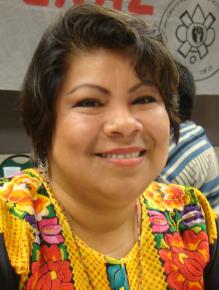The struggle of Oaxacan teachers goes on
IN MAY 2006, 70,000 teachers in the Mexican state of Oaxaca went on strike to prevent the privatization of education and demand more funding for student services. Oaxaca's governor, Ulises Ruiz Ortiz of the Institutional Revolutionary Party (PRI), responded with violent police attacks against the teachers' strike encampment.
One month later, numerous organizations came together in the People's Popular Assembly of Oaxaca (APPO) to support the teachers and push for Ruiz's ouster. APPO organized several mass marches throughout the summer and fall.
Following further repression by the Ruiz government, paramilitaries and the federal police, the Oaxaca section of the National Union of Education Workers (SNTE) voted in late October to end the strike, in order to avoid a split with more conservative teachers in smaller towns. In late November, federal police removed APPO's last encampment.
In all, government repression resulted in hundreds of arrests and 23 activists killed. Yet APPO and the Oaxacan teachers have continued to organize in the 18 months since the strike.
Eustolia Mateos Luna is secretary general of Local D-1-211 of Section 22 of the National Union of Education Workers (SNTE) and a leader of the Coalition of Indigenous Teachers and Promoters of Oaxaca (CMPIO). She talked to and about conditions in Oaxaca today.
DESCRIBE THE context in which you organize
WE WORK in indigenous education. After the repression we saw in 2006 in Oaxaca, the CMPIO is trying to develop the consciousness of young teachers who work in indigenous communities and to involve parents in the movement to prevent privatization of education.
We work with highly marginalized communities. We have teachers who walk 8 or 12 hours to arrive at their place of work [in the mountains]. The demonstrations we've been involved in have been based precisely on the fight for the needs of our indigenous communities.
HOW DID the struggle of 2006 change the people who participated in the movement?
FIRST OF all, the teachers' struggle became a people's struggle. People saw that our demands were for the needs of the community, and that we were demanding a better education for everyone. It wasn't just about a salary increase: we were demanding what the government in Oaxaca had taken away from us as teachers, as people, as indigenous communities.
The people saw that the struggle was just, and they no longer wanted to allow the aggression against us. So they rose up and demonstrated, too, and we formed APPO.
But obviously, the repression that we saw also intimidated people. It was intended to create fear. And the media began to work very hard to pit the people against the teachers.
In this struggle we achieved a great advance in consciousness, both of ourselves as teachers and of the people in general. But the dirty work that the government has done has confused people [into thinking the movement is over].
In reality, we are continuing the battle. The struggle is no longer as it was in 2006, but it continues with outbreaks of protest by different organizations. They say that they've restored "governability" in Oaxaca, but it's not true.
HOW IS the struggle in Oaxaca connected to the broader struggle for democracy in Mexico?
ONE THING that the people saw through the struggle in Oaxaca was that we need a government of the people. We need a government that really serves the interests of the native peoples, and which has a vision of change and equality, because there is deep inequality in our country.

The corruption is very severe. We know that both the federal and state governments are often imposed on us by capitalist forces. So the poor class is robbed of its voice. We feel that the struggle in Oaxaca was like a wake-up call to raise the consciousness in many states. Unfortunately, they had to see blood in Oaxaca.
So in many states, there is fear to raise your voice, precisely because of the repression that we saw in Oaxaca. But there's still a great resistance.
WHAT'S THE current state of the teachers' struggle in Oaxaca?
THE GOVERNOR'S goal was to divide us as a union. So what he did was begin to form groups independent of Section 22. But those who are still in Section 22 are the majority. And we are still fighting against the governor.
There is a very strong internal crisis in APPO and in Section 22. But we can't let the governor divide us. He wants to divide this huge force so that he can say, "They aren't many, they're just a few guerrillas," which isn't true.
There has been so much manipulation by the media. But something historic happened during the struggle: the takeover of the TV station and all the radio stations--they were all in the hands of APPO. That's why it was so important for Ruiz to take back the stations--so that we could no longer transmit the truth.
WHAT LESSONS did people learn?
SOMETHING THAT was very important for us was the support of our brothers and sisters who are immigrants in the U.S, and from other comrades. We received solidarity in the most critical moments of the struggle. This solidarity let the Oaxacan people know that we were not alone. The Oaxacan struggle crossed borders.
With this solidarity, we can take on the great challenges that face public education. Public education is so important so that no one should be able to take it away from us. And this is what Oaxaca has always fought for: the return to the indigenous people of what belongs to them, what the government has stolen.
That's what other countries can do, too: to demand what is ours, especially public education, because there's no reason to privatize it. This will only hurt the poor, because not everyone can afford a private education. What private education would bring is for us all to learn nothing more than what's in the interests of the rich.


